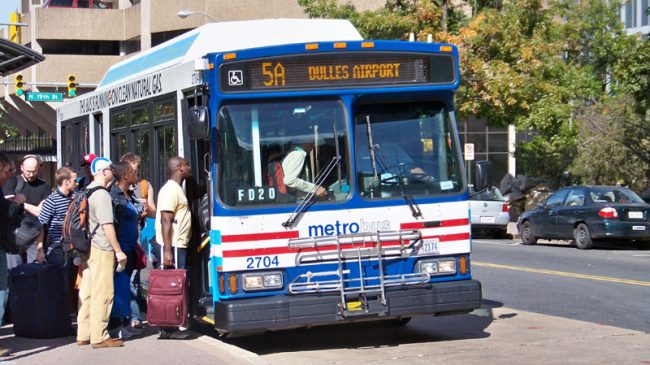In the hopes of improving “livability” conditions and stimulating real estate development, Arlington County officials are pressing on with their plan to replace bus service with a streetcar line on the Columbia Pike. Approved for construction in 2012, the 4.9-mile track-based line would connect Skyline in Fairfax County to Pentagon City in Arlington, a corridor in which demand for transit currently exceeds supply. Notwithstanding the sexy nature of trains, improving bus service would benefit residents more than switching to streetcars.
From the outset, this project has been expensive. At the time of the project’s approval in 2012, cost estimates came in near $250 million. Operating the streetcar system will incur an additional $22 to $26 million a year. Arlington County officials originally hoped that the federal government would cover 30% and the state 14% of the county’s $200 million share.
Since then cost projections have exploded. Changes in the size of streetcar vehicles, higher than expected engineering fees and new inflation and risk assessments have ballooned the streetcar’s price tag to $333 million. Since last year, the State of Virginia has raised its contribution by $65 million to nearly one half of total project costs. Although this is in place of federal involvement, it nevertheless holds Virginia’s nearly 4 million taxpayers liable for a project from which the vast majority will never benefit. The putative $4.4 billion in “economic benefits” that planners tout will, if anything, simply widen the growing wealth cap between the nation’s capital and the rest of the country.
Not only are these costs massive and inequitable, they also create moral hazards that promise to plague construction. The prevalence of government grants in the county’s funding scheme predisposes it to cost and schedule overruns. Because both county officials and contractors have shifted risk to taxpayers, neither party will work hard to minimize project creep. With seven years to go until the current completion deadline, there is ample time for costs to soar even higher.
In addition to their high cost, streetcars have two major disadvantages compared with buses. First, their reliance on tracks makes them highly inflexible. Streetcars are far more vulnerable to power outages than buses because they run on electrified rail. Recently, a streetcar in Tucson, Arizona had to be towed when a bolt of lightning struck its support wire. Similar incidents in Portland, Toronto and other cities demonstrate that bad weather can halt streetcar service even in the absence of a power grid failure. Similarly, car accidents on streetcar lines, or with the streetcars themselves, would lead to extensive backlogs. Because the Columbia pike streetcar will operate in mixed traffic and most drivers are inexperienced in sharing the road with this form of transit, Arlington can expect to see a rise in accidents and delays come 2021. In contrast, buses can navigate out of congested lanes or take alternate routes and are not constrained by bad weather.
Second, streetcars have less capacity than their proponents claim. In Portland Oregon, for example, streetcars are much larger-66 feet versus 40 feet long-than buses and thus appear to hold more people. In actuality, however, they seat twelve fewer passengers-31 compared with 43-than the “smaller” buses. Although streetcars’ larger size allows more people to stand, double-decker buses close this gap cost-efficiently. Las Vegas’s double-deckers each contain 85 seats and enough room to stand as many additional passengers. At $750,000 apiece these vehicles are far cheaper than the track-bound, infrastructure-intensive streetcars and offer passengers a far more comfortable ride.
Instead of spending hundreds of millions of taxpayer dollars on a deeply flawed mode of transit, planners could enhance existing bus service for a fraction of the cost. Increasingly, cities are upgrading their bus fleets with Intelligent Transportation System (ITS) technology. This involves outfitting buses with radio/GPS emitters that send real-time updates on bus speed and location to traffic lights. Upon reception of the radio signals, the traffic light’s internal timer prolongs green lights and shortens red lights for approaching buses.
Signal prioritization increases bus speeds and keeps them evenly spaced. As a consequence, passengers enjoy shorter wait and travel times. If supplemented by high capacity bus models and limited-access underpasses, ITS upgrades would allow buses to better satisfy transit demand on the Columbia Pike.
Arlington County’s plans for the Columbia Pike place style over substance. Streetcars involve higher infrastructure costs, higher operational costs, unpredictable stoppages and uncomfortable travel for passengers. That planners characterize streetcar projects in terms of urban “livability” and “development,” first, and in terms of mobility and cost-effectiveness, second, is no mistake. Even at the local level, transportation policy ought to be about shortening commute times and saving taxpayer money; not gentrifying neighborhoods or stimulating commerce. While it is probably too late for Arlington to kill this boondoggle, other counties should see it as a cautionary tale of transportation policy gone wrong.
